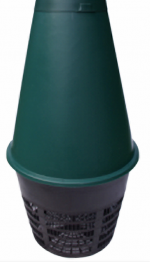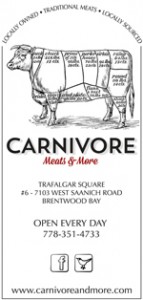Out of Sight, Out of Mind – Two Ways to Recycle Kitchen Scraps
Effective January 1, 2015 kitchen scraps were banned from Hartland landfill. The Regional Kitchen Scraps Strategy was developed by the Capital Regional District (CRD) to promote sustainable waste management for the region. As a result, all residences and businesses in the region are required to segregate food scraps from regular garbage.
The CRD estimates that organic material, such as kitchen scraps, constitute approximately 30% of the waste at the landfill. Current recycling programs are diverting 46% of the waste stream from the landfill, and a goal of 70% is envisioned by diversion of kitchen scraps.
Sidney and Saanich are both directed by municipal services and included in property taxes while residents of North, and Central Saanich rely on private companies for collection. In those areas, there are at least two companies that pickup kitchen scraps separately from regular garbage: Pan-Insula Disposal (Pan-D), and Capital City Recycling (CCR). Waste Management also has a local service pick-up but does not accept the separate organic material, according to their service agent. Repeated attempts to contact BFI Canada failed. Both Pan-D and CCR charge nearly the same for regular garbage pickup, $52 for three months, per can, but CCR charges an extra $13.48 for three months for the addition of kitchen scraps, but supplies the extra tote free of charge. Pan-D allows you to use your own bin.
Some residents in Central Saanich have complained about the need for several different companies plying the roads with large trucks but according to Coun. Chris Graham, “The competition between companies keeps prices low.”
Coun. Bob Thompson takes his own garbage and recycling to Hartland or DL Bins “for about $ 80.00/year,” he says, adding that he has no desire to pay more then that in taxes for a municipal service.
For some residents, backyard composting makes sense. And while most kitchen scraps compost well using regular composting methods, the CRD says that some items, such as meat, fat, and bones, cannot be properly composted in a typical composting bin. For these items an alternative method of composting may be best – enter the compost digester.
 Compost digesters are designed to break down or ‘digest’ organic material that regular composters cannot. Some are the shape of an inverted cone which is partially buried in the soil. Kitchen scraps are added at the top, the unit is heated by the sun, and scraps are reduced primarily to nutrient-rich liquid which permeates the surrounding soil, providing nourishment to nearby plants.
Compost digesters are designed to break down or ‘digest’ organic material that regular composters cannot. Some are the shape of an inverted cone which is partially buried in the soil. Kitchen scraps are added at the top, the unit is heated by the sun, and scraps are reduced primarily to nutrient-rich liquid which permeates the surrounding soil, providing nourishment to nearby plants.
Central Saanich Coun. Zeb King has several digesters in his backyard. “While the CRD dithers, debates and continues to send kitchen scraps to the lower mainland at considerable cost to the taxpayer, a solution is right at hand,” says King. King has been testing two types of cones, the Green Cone and the Bard Matic. King says that he prefers the Bard Matic, because “It is simple and doesn’t require excavation to retrieve the basket at the bottom of the cone in, say, 2-3 years. All you do is pull out the cone and bury the compost gold.” Both cones sell for about $160. The Green Cones are in use at Stelly’s High School.
The Compost Education Centre of Victoria has been in the forefront of composting in the region. They have available many types of composters and digesters together with fact sheets covering their installation and use. They even have instructions for making a backyard digester out of an old plastic garbage container.
King has asked them to provide a workshop for Peninsula residents.
 For community-minded gardeners, a larger digester that is hand cranked and handles kitchen scraps from several families might be a solution. The finished product is soil for the garden that could be shared among the participating families. The SunMar 400 is just such a digester. Mr. King has been using two of them for some time and says that ‘It takes no time to decompose kitchen scraps most times of the year except the colder days of winter. For those days, the cones are best.’
For community-minded gardeners, a larger digester that is hand cranked and handles kitchen scraps from several families might be a solution. The finished product is soil for the garden that could be shared among the participating families. The SunMar 400 is just such a digester. Mr. King has been using two of them for some time and says that ‘It takes no time to decompose kitchen scraps most times of the year except the colder days of winter. For those days, the cones are best.’
""
In the following on-line video, he demonstrates three different types of digesters.











As a tenant, I love having access both to the cone and crank digesters on the property. Once a day the food scraps get dumped in either one (cone does better with bone and fats) and its gone. No worry about whether a bin will need to be put out on a certain morning. No worries about keeping the bin sanitary (curb side food scrap bins can get infested with maggots and stink). I’m all for backyard composting!!
What a great review of different composting methods, it really shows what can be easily done on a small urban lot. This is an ideal way to reduce organics from being trucked out of the region and saves money by avoiding buying back top soil to fertilize the garden. By altering our routine we can all be more self sufficient and reduce our impact on the environment.
Very educational, keep up the good work Zeb!